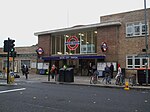Dimco Buildings

The Dimco Buildings are a historic structure in White City, London, just north of Shepherd's Bush. Originally built in 1898 along with Wood Lane depot, they were constructed as a power station for the Central London Railway (precursor of the London Underground's Central line). The architect was Harry Bell Measures. These buildings now constitute the earliest extant example of an electricity generating station built for the London Underground. The power station closed on 18 March 1928 when power for the line began to be supplied from Lots Road Power Station. The building was later used by the Dimco power tool company. Today the Dimco Buildings house White City bus station, located next to the Westfield London shopping centre, one of the largest in Europe. The Dimco Buildings are Grade II listed. The Dimco buildings were used as a filming location for the Acme Factory in the 1988 film Who Framed Roger Rabbit, and later served as the interior of the British Museum in The Mummy Returns.
Excerpt from the Wikipedia article Dimco Buildings (License: CC BY-SA 3.0, Authors, Images).Dimco Buildings
Ariel Way, London
Geographical coordinates (GPS) Address Website External links Nearby Places Show on map
Geographical coordinates (GPS)
| Latitude | Longitude |
|---|---|
| N 51.5087 ° | E -0.2231 ° |
Address
Exhibition London
Ariel Way
W12 7SL London (London Borough of Hammersmith and Fulham)
England, United Kingdom
Open on Google Maps







